
 |
| 2.2.6 |
The Effect of El Niño in a Global Context |
| El Niño causes a change in weather centered on the Galapagos. In severe El Niños these changes can be felt globally. The global changes are not easily predicted but it can be said that a severe El Niño will cause a change in the normal weather patterns on Earth. Often normally wet areas are dry and normally dry areas are wet. Storm patterns may also be redirected. |
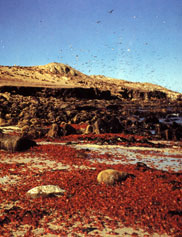 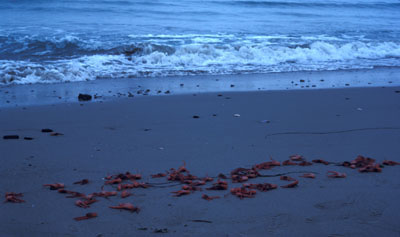 |
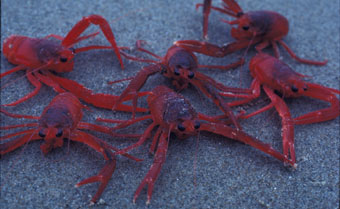 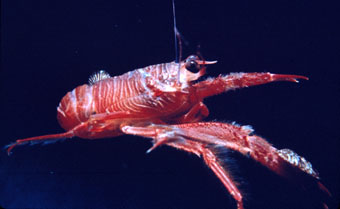 |
| California may experience warmer ocean temperatures after a severe El Niño. The warm water, centered on Galapagos, transfers its heat out. In severe El Niños the waters of California may warm several degrees above normal (more pronounced in Southern California than in Northern California). This warming will change the environment for California's marine life. Species that can not tolerate this warming may die (or move north to cooler water). If the warmth creates an abnormal thermocline it will lock nutrients out of the surface waters and marine plants may be affected. Tropical marine forms (from Mexico) may migrate north in the warmer waters (like red crabs) and change the California marine environment. In general, when the water returns to its normal temperature these tropical species disappear. |
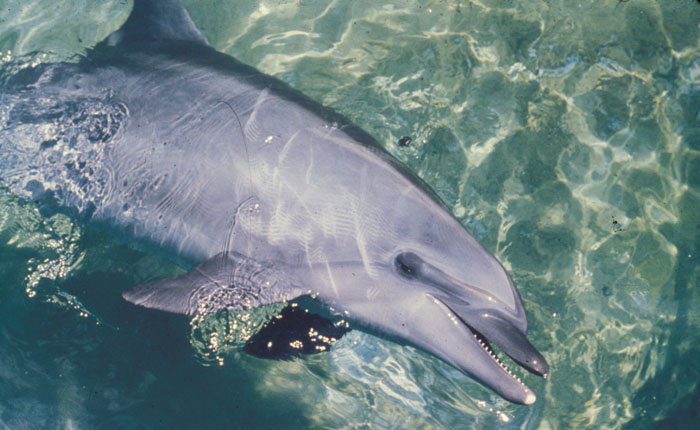 |
| Exotic species may stay after El Niño. During the '82/'83 El Niño a group of bottlenose dolphins moved up the coast of California from the Los Angeles area. They continued to stay in the area above Los Angeles (near Ventura and Santa Barbara) even after the El Niño disappeared and remain there today. This group of dolphins is a range extension for the coastal bottlenose dolphin. Before '82/'83 there was not a resident population in the Ventura/Santa Barbara area but they are here now and have remained healthy and are reproducing. They are a common sight along the freeway that runs between Ventura and Santa Barbara as they often play in the waves that are easily seen along this stretch of coastline. |
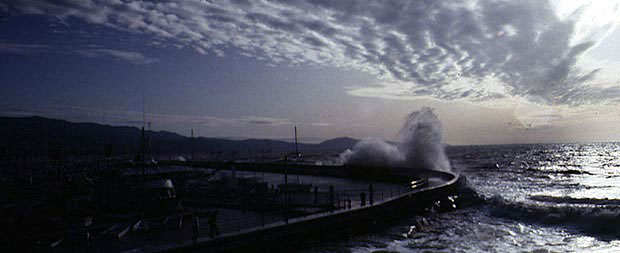 The Santa Barbara Breakwater public walkway was covered by big waves and seawater in the winter of 1983 due to El Niño. (GA image) |
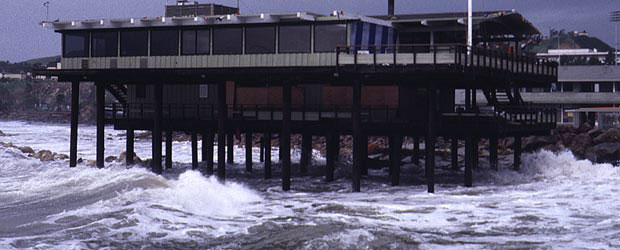 |
The Santa Barbara Yacht Club was built on a sandy beach but in the winter of 1983 all of the sand was removed by the global El Niño. (GA image) |
 |
| California may experience a series of severe storms after a severe El Niño. During the '82/'83 El Niño event the jet stream in the atmosphere changed its normal position and funneled a series of storms to Southern California. These storms would normally have come ashore in Northern California and the States of Washington and Oregon. The storms brought huge amounts of rain. As the storms hit, one after another, the ocean water piled up along the central and southern California coast creating higher sea levels (a storm surge). When big waves were associated with high tides (and this increased sea level due to the storm surge) the coast of California suffered millions of dollars of damage and ocean water came inland to areas that no one ever thought would be affected by storm waves. The Santa Barbara Harbor was closed for six weeks, in March 1983, and had thirteen million dollars of damage. During the 1982-83 event the cost to California was more than 300 million dollars with 10,000 people being evacuated and 12 deaths. |
 |
| Southern California experienced billions of dollars of damage in the '82/'83 El Niño. The Los Angeles area had triple the normal amount of rainfall and numerous storms battered coastal towns with a loss to homes and business. |
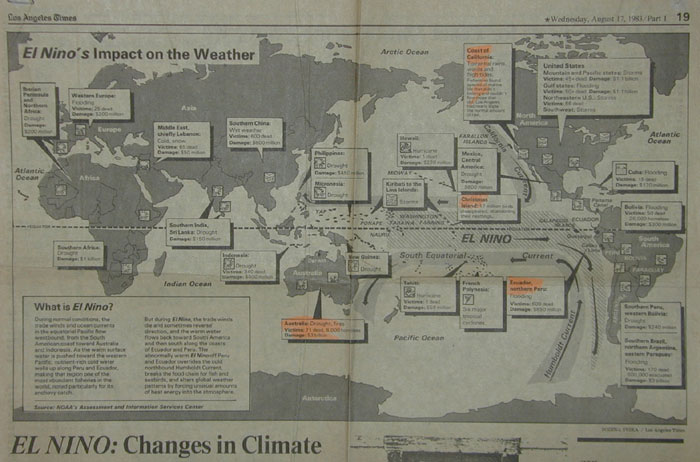 |
| Droughts, floods and storms are worldwide consequences due to severe El Niños. For example, Australia's East Coast may experience a drought after a severe El Niño. The East Coast of Australia is usually where the Trade Winds bring moisture-laden air from across the Pacific. As this air rises over Australia it drops its moisture on the eastern coastline. Tropical and temperate rain forests occur here. During severe El Niños there is little rainfall and severe droughts develop in Australia's normally wet eastern coast. Also, Australia's Great Barrier Reef may experience exposure after a severe El Niño. During severe El Niños, where a Kelvin Wave develops, the sea level of the Great Barrier Reef (on Australia's northeast coast) may decrease by as much as 6 feet. In some of the reef areas this would bring the living coral above the ocean and into the air for days on end. Some corals are able to tolerate a certain level of exposure but others are more sensitive and all species must have some emersion in seawater. The living tops of many of the coral reefs in Australia's world-renowned Great Barrier Reef died or had considerable damage during the severe '82/'83 El Niño. Seventy one Australians died during the '82/'83 El Niño, 8,000 became homeless and a total of three billion dollars worth of damage was done in this country. |
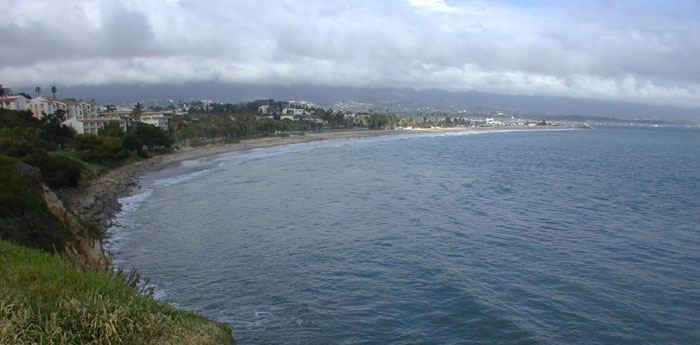 |
| A return to 'normal' occurs after El Niños. This return to a more normal situation may take a few days (if the El Niño is not severe), months, years, or may be permanent. In California most of the marine areas returned to a more normal situation after the '82/'83 event but a few of the Southern California kelpbeds, that were severely affected by the warm water and lack of nutrients, never have recovered. One of these locations is at Leadbetter Beach, Santa Barbara, California. Leadbetter Beach is right across the street from Santa Barbara City College and where a small kelpbed was studied by students from the Marine Technology and Biological Sciences Departments from the early 1960s until a few years after the '82/'83 El Niño. The kelpbed all but died out in the '82/'83 El Niño. The studies conducted by the students for the few years after 1983 showed a few kelp plants growing but they never formed an established bed again. After a couple of years it was no longer a suitable site for kelpbed study and has remained this way for over 20 years. Finally in the spring of 2003 a small kelpbed can be seen, once again, at the surface. |
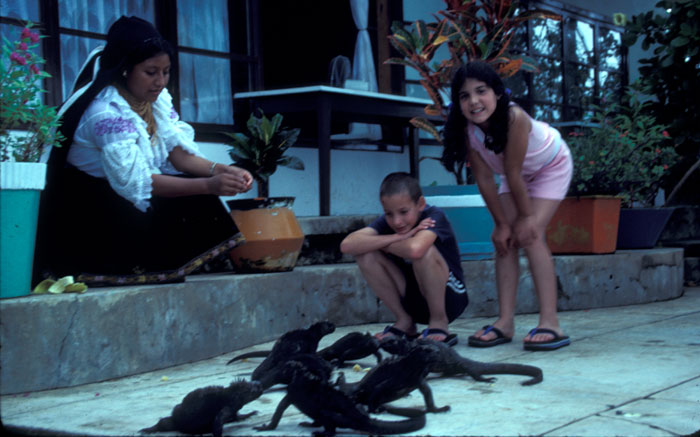 |
| Galapagos species return to 'normal' on a regular basis. The marine and terrestrial species living in Galapagos are subjected to El Niños on a much more regular basis than the rest of the world (every 3-10 years). After the '82/'83 El Niño the marine iguanas actually had increased reproduction for a few years after they recovered their health and the survival rate of their young was above normal until the populations reached their 'normal' levels. The red footed boobies returned and all of the fish-eating birds began to reproduce again. The Galapagos sea lions once again became healthy as the fish populations returned. |
 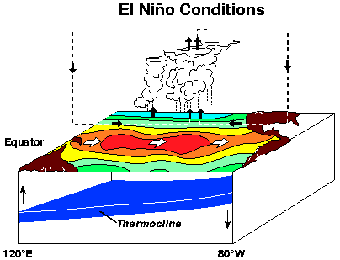 |
Normal (left) and El Niño (right) conditions in diagramatic form. Note the white arrows indicating the direction of the Trade Winds (from east to west in normal conditions and reversing from west to east in El Niño conditions). In many El Niños the Trade Winds may not actually reverse, they just slow down or stop. Note, also, the depth of the thermocline (shallow near Galapagos in normal conditions and deep in El Niño conditions). (NOAA images) |
| Since the '82/'83 El Niño an ocean monitoring program was established near Galapagos showing when El Niños begin. Most of this was done by NOAA (the National Oceanic and Atmospheric Administration). The monitoring stations record wind direction, wind speed, ocean water temperature, ocean water nutrient levels and many other parameters. As the Trade Winds slow around Galapagos sea surface temperature increases and nutrients decrease. This type of information is used to predict the beginning of an El Niño. It is continued monitoring that will tell how long (severe) the El Niño will be and if it will have global consequences. |
  |
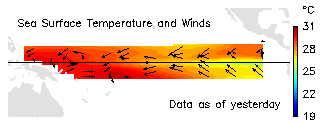 |
| Up-to-date information about El Niño is made available by NOAA (the United States National Oceanic and Atmospheric Administration). (NOAA image) |
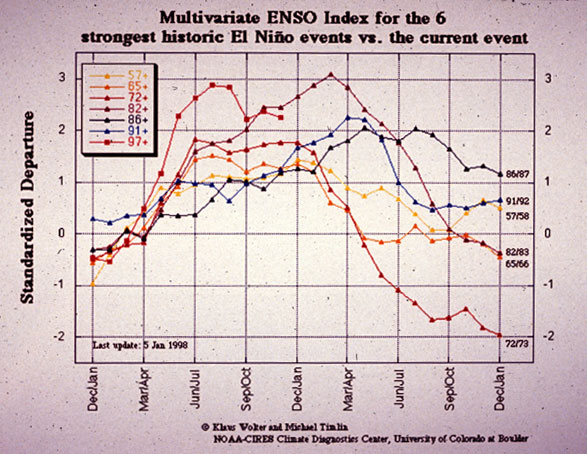 |
This 1998 graph was created by NOAA to compare El Niños. The zero line is for 'normal' conditions. Departures from the normal conditions representing an El Niño (weaker Trade Winds, higher sea surface temperatures across the Pacific, increased rainfall in Galapagos, decreased surface ocean nutrients in Galapagos) are shown as positive values. Departures from the normal conditions that are the opposite of El Niño conditions (stronger Trade Winds, cooler sea surface temperatures across the Pacific, decreased rainfall in Galapagos, increased surface ocean nutrients in Galapagos) are shown as negative values. The use of ''multivariate' means that all these factors (and more) are taken into consideration. Notice the '82/'83 El Niño remains as the 'strongest' (over a +3) although the 1997 El Niño started earlier and increased more rapidly. The 1997 El Niño (not completed in this graph) actually ended up lasting longer than the '82/'83 El Niño so they are both important severe El Niños in history. (NOAA image, 1998, no longer available) |
| El Niños are connected with the Southern Oscillation, a meteorological phenomenon in the South Pacific. This oscillation of high and low-pressure areas may be one of the forces that affects the Trade Winds. Scientists who study El Niños usually refer to them as ENSO phenomena (El Niño Southern Oscillation). |
   |
Normal (left), El Niño (center), and La Niña (right) conditions. Note the bulge in sea level in the western Pacific in normal years (this is around Australia). Then note the effect of the Kelvin wave in a severe El Niño as it 'sloshes' back across the Pacific Ocean creating higher than normal sea levels around Galapagos and lower than normal sea levels near Australia. The ocean depths shown here range from the surface to about 650 or 700 feet. (NOAA images) |
| La Niña is the opposite of El Niño. This description was coined for the effects of stronger than normal Trade Winds resulting in cooler water across the tropical Pacific. Like in a severe El Niño (when the heat from the 'warmer than normal water' is transferred to the atmosphere), during a severe La Niña the 'cooler than normal water' across the Pacific transfers this coolness to the atmosphere. In both cases weather patterns can be changed on Earth due to the different atmospheric conditions. Recently, scientists from the University of California at Santa Cruz are using the term "La Nada" for the 'normal' years so now we have El Niño (warmer), La Niña (cooler), and La Nada (normal) years of oceanographic conditions. |
| Planet Earth is complex and interesting. Studies of the interactions between the physical factors (winds, waters, temperature, rainfall), and the biological factors (plants, animals and other life forms) on Earth are always astounding. The phenomenon of El Niño remains one of the foremost ones in this century especially when it has global consequences. El Niño has become a household word around the world since the 1982-83 event. |
(Revised 6 August 2007) |